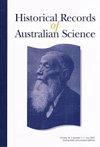Reverend Voyce and Père O'Reilly's excavated collection from Bougainville: a case study in transnational histories of archaeology in the Pacific
IF 0.4
4区 哲学
Q4 HISTORY & PHILOSOPHY OF SCIENCE
引用次数: 1
Abstract
This paper considers the transnational collection, interpretation, and circulation of archaeological material acquired in North Solomon Islands (now the Autonomous Region of Bougainville) by Hobart born Methodist missionary the Reverend A. H. Voyce (1899–1984). In 1935, he gave an archaeological assemblage to Father P. O’Reilly, a French Marist priest, in the region to fulfil an ethnographic mission for the Musee d’Ethnographie du Trocadero/ Musee de l’Homme in Paris, France. Understanding the context of their encounter through international missionary networks, and the subsequent curation and interpretation of the artefacts collected by Voyce in multiple countries and according to different academic traditions, requires an approach that transcends traditional, nationally framed histories. Voyce and O’Reilly were from different socio-cultural and religious backgrounds, deeply inscribed in different national histories. Yet, they were nodes in an extensive network linking early twentieth-century ‘missionary-ethnographers’, Pacific interlocutors, and international scholars that could sometimes transcend language and denominational barriers. Both Voyce and O’Reilly shared a particular interest in ancient artefacts that has positioned them as important contributors to the early twentieth-century formulation of Pacific archaeology; their collections and the ideas they supported quietly becoming significant legacies for the discipline. We cross-analyze the sets of data we have been gathering independently on Voyce and O’Reilly to examine this collection’s story as an exemplary case-study in the transnational history of science.voce牧师和p re O'Reilly从布干维尔岛发掘的藏品:太平洋地区跨国考古学史的案例研究
本文考虑了霍巴特出生的卫理公会传教士a·h·沃伊斯牧师(1899-1984)在北所罗门群岛(现布干维尔自治区)获得的考古材料的跨国收集、解释和流通。1935年,他为法国巴黎的特罗卡德罗民族博物馆(Musee d’ethnographie du Trocadero/ Musee de l’homme)完成一项民族志任务,在该地区向法国圣母会神父p·奥莱利(P. O’reilly)提供了一个考古集合。通过国际传教士网络了解他们相遇的背景,以及随后根据不同的学术传统对Voyce在多个国家收集的文物进行整理和解释,需要一种超越传统的、国家框架的历史的方法。沃伊斯和奥莱利来自不同的社会文化和宗教背景,深深烙印在不同的国家历史中。然而,他们是连接20世纪早期“传教士民族志学者”、太平洋对话者和国际学者的广泛网络中的节点,有时可以超越语言和教派的障碍。沃伊斯和奥莱利都对古代文物有特别的兴趣,这使他们成为20世纪早期太平洋考古学的重要贡献者;他们的收藏和他们所支持的思想悄悄地成为这门学科的重要遗产。我们交叉分析了我们一直在独立收集的关于沃伊斯和奥莱利的数据集,以检验这个系列的故事,作为跨国科学史上的典范案例研究。
本文章由计算机程序翻译,如有差异,请以英文原文为准。
求助全文
约1分钟内获得全文
求助全文
来源期刊

Historical Records of Australian Science
HISTORY & PHILOSOPHY OF SCIENCE-
CiteScore
0.90
自引率
66.70%
发文量
22
期刊介绍:
Historical Records of Australian Science is a bi-annual journal that publishes two kinds of unsolicited manuscripts relating to the history of science, pure and applied, in Australia, New Zealand and the southwest Pacific.
Historical Articles–original scholarly pieces of peer-reviewed research
Historical Documents–either hitherto unpublished or obscurely published primary sources, along with a peer-reviewed scholarly introduction.
The first issue of the journal (under the title Records of the Australian Academy of Science), appeared in 1966, and the current name was adopted in 1980.
 求助内容:
求助内容: 应助结果提醒方式:
应助结果提醒方式:


